Background to the National Monument
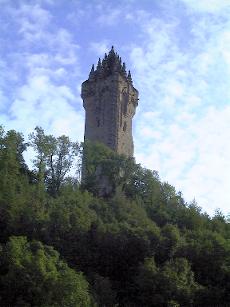 The idea for a monument to one of Scotland's National Heroes began in the 1830s on a world-wide tide of Scottish nationalism. Remember that Sir Walter Scott was fanning these flames - he had rediscovered the "Honours of Scotland" (crown, sword and sceptre) in Edinburgh Castle in 1818, 111 years after they had been locked away after the Union of the Parliaments in 1707. And of course his novels had led to a re-awakening of an interest in Scotland's history.
The idea for a monument to one of Scotland's National Heroes began in the 1830s on a world-wide tide of Scottish nationalism. Remember that Sir Walter Scott was fanning these flames - he had rediscovered the "Honours of Scotland" (crown, sword and sceptre) in Edinburgh Castle in 1818, 111 years after they had been locked away after the Union of the Parliaments in 1707. And of course his novels had led to a re-awakening of an interest in Scotland's history.
A group of prominent Scots formed a National Monument Committee in the 1830s. However, in typical committee fashion, it took until the 1850s before serious steps were taken to build a monument. Initially the preferred site was Glasgow Green - Wallace's connection with this site is hard to discern! However, on the instigation of the Rev Dr Charles Rogers, the chaplain at Stirling Castle, the site at Abbey Craig was selected. Since 1709 the land had been owned by the Patrons of Cowanes Hospital, a charity established in 1637. Cambuskenneth Abbey (founded around 1147 by King David I) sits at the foot of Abbey Craig.
A public subscription was launched and a design competition was organised. The winner was an Edinburgh architect, J T Rochead. When the foundation stone was laid in 1863, a crowd of 70,000 were present. But disputes amongst the National Monument Committee members and financial problems resulted in construction not being completed until 1869.
Description of the Monument
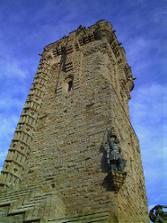 The Wallace Monument is situated on the top of Abbey Craig, overlooking the river Forth and the Forth Valley. Only Stirling Castle, a few miles away across the river Forth, makes a bigger impression on the area. Abbey Craig at one time was the site of a hill fort and in 1297 William Wallace camped there before defeating the English attempting to cross the Forth at the Battle of Stirling Bridge.
The Wallace Monument is situated on the top of Abbey Craig, overlooking the river Forth and the Forth Valley. Only Stirling Castle, a few miles away across the river Forth, makes a bigger impression on the area. Abbey Craig at one time was the site of a hill fort and in 1297 William Wallace camped there before defeating the English attempting to cross the Forth at the Battle of Stirling Bridge.
The design of the monument is in the Scottish "Baronial" style and represented a Scottish Medieval tower, rising from a courtyard, with a representation on the top of the Crown Royal of Scotland. The design has been much criticised for its fanciful combination of secular and ecclsiastical elements.
The monument is 220 feet high, 54 square feet at its base, with the tower 36 square feet. The walls are 16/18 feet at their thickest, tapering to 5 feet thick at their thinnest. It is estimated that there were in excess of 30,000 tons of stones used in the construction.
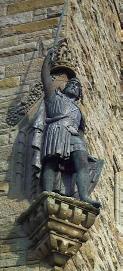
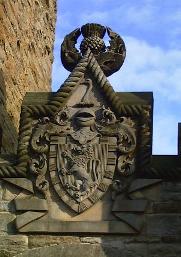
The statue of Wallace on the outside of the building is solid bronze and was sculpted by David Watson Stevenson. It is situated approximately 30 feet from the ground, and the statue itself stands around 15 feet tall.
Other motifs on the building include the Scottish Thistle, the Wallace coat of arms - surrounded by a knotted rope (see graphic above, right).
The monument was built with a caretaker's house attached. Today, that space is now occupied by a tea room (which was originally the caretaker's kitchen and parlour).
Inside the Monument
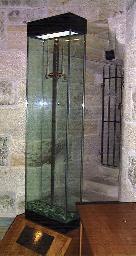
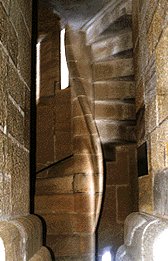 Internally there are four rooms in the tower of approximately 25 square feet, with vaulted ceilings 20/30 feet high. The tower rooms are connected by a spiral staircase (see right) in the north-west corner - and there are 246 steps to the top.
Internally there are four rooms in the tower of approximately 25 square feet, with vaulted ceilings 20/30 feet high. The tower rooms are connected by a spiral staircase (see right) in the north-west corner - and there are 246 steps to the top.
The ground floor room contains the inevitable souvenir shop - with a video player and TV screen continuously playing the Mel Gibson "Braveheart" film. The staff there must know the words off by heart by now!
The other rooms at each stage on the way up the tower offer a welcome respite to visitors unused to climbing over 200 feet and 246 steps. At the first level is an audio visual presentatiion on Wallace and his achievements. But it is the 700 year-old Wallace sword (left) which makes the biggest impression.
The sword is a traditional two-handed broad-sword, 71.5 inches in length. It weighs six pounds. Little is known about the origins of the sword for it carries no maker's mark and is therefore difficult to date. The quality of the metal used for the blade suggests that it may have been forged in Scotland (unlike other swords of the period which were often Flemish or German in origin). We do know, however, that King James IV ordered the sword to be rehilted in 1505, so that it would be more fitting to Scotland's National Hero. The size of the sword indicates that Sir William Wallace must have been at least six feet six inches tall.
The sword was traditionally kept in Dumbarton Castle until 17 November 1888 when it was handed over in Stirling Castle - to Rev Charles Rogers who had started the Wallace Monument project in the first place.

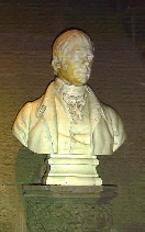
Hall of the Heroes
Up more of the spiral staircase, at a higher level, is the "Hall of Heroes" containing busts of sixteen well known Scots. Since a number of these have been presented by individuals and organisations and reflect 19th and early 20th century views, the entire selection is not perhaps the "top 16" on everyone's list. (The inclusion of Gladstone in this company may seem particularly odd but although he was born in Liverpool, his parents were both Scots and he claimed "there is not a drop of blood in my veins that is not Scottish). Please note also that the spelling of William Murdock's name is "correct". He changed to that spelling when he moved to England!
The busts are of :
- Sir David Brewster (1781 - 1868), scientist and inventor.
- Robert the Bruce (1274 - 1329), King of Scotland and national hero.
- George Buchanan (1506 - 1582), historian and scholar.
- Robert Burns (1759 - 1796), poet.
- Thomas Carlyle (1795 - 1881)writer and sage.
- Thomas Chalmers(1780 - 1847), preacher and writer.
- William Ewart Gladstone (1809 - 1898), politician and UK prime minister.
- John Knox (1505 - 1572), religious reformer. (Graphic above, left)
- David Livingstone (1813 - 1873), missionary and explorer.
- Hugh Miller (1802 - 1856), writer and geologist.
- William Murdock (1754-1839), pioneer of gas lighting.
- Allan Ramsay (1685 - 1758), poet and man of letters.
- Sir Walter Scott (1771 - 1832), writer, poet and nationalist. (Graphic above, right)
- Adam Smith (1723 - 1790), economist and philosopher.
- Robert Tannahill (1774 - 1810), songwriter.
- James Watt (1736-1819), inventor and developer of the steam engine.
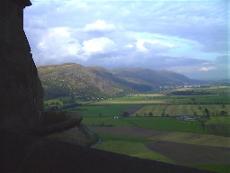 At the top of the tower there is a parapet from which magnificent views across the Forth valley can be obtained to Stirling and its Castle and, in the other direction, the Ochill Hills.
At the top of the tower there is a parapet from which magnificent views across the Forth valley can be obtained to Stirling and its Castle and, in the other direction, the Ochill Hills.



